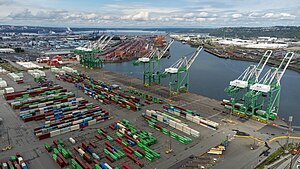|
Port of Tacoma
The Port of Tacoma is an independent seaport located in Tacoma, Washington. The port was created by a vote of Pierce County citizens on November 5, 1918. The Edmore was the first ship to call at the port in 1921. The port's marine cargo operations, among the largest in the United States, was merged with the Port of Seattle's in 2015 to form the Northwest Seaport Alliance. HistoryThe port started out on 240 acres (0.97 km2) of land, and now owns more than 2,400 acres (972 hectares) of land that are used for shipping terminal activity, warehousing, distributing, and manufacturing. Nineteenth CenturyPrior to the establishment of the Port of Tacoma, much of Tacoma's shipping activity took place along Ruston Way and along the mouth of the Thea Foss Waterway, which opens into Commencement Bay and the larger Puget Sound. Tacoma's role as a shipping center dates to 1853, when the first cargo of lumber was shipped to San Francisco.[2] Tacoma's status as a major trading hub was greatly strengthened by the 1873 decision by the Northern Pacific Railroad to establish its western terminus at Commencement Bay. Tacoma was chosen over other nearby cities such as Seattle for several reasons: Commencement Bay could dock more than 50 ships at a time, the harbor was deep enough for vessels of any draft, and there were miles of tideland waterfront available for expanded port facilities.[2]   Settlement with Puyallup TribeThe United States Army Corps of Engineers straightened the Puyallup River between 1948 and 1950, leading to litigation in the early 1980s over ownership of 12 acres of land formerly in the riverbed. The Puyallup Indian Tribe won their case in federal court.[3] Subsequently, The Puyallup Tribe of Indians Settlement Act of 1989 ceded the Tribe's remaining land claims over 120 acres of the Port of Tacoma,[4] in exchange for $162 million and other benefits.[5][6][7][8][9][10] The claims dated to the 1856 Medicine Creek Treaty and the Puyallup's 1856–1857 renegotiation of their reservation boundaries at Fox Island. The reservation still exists legally and includes at least the Port's land between Hylebos and Blair Waterways and the entire city of Fife.[3][7] Northwest Seaport AllianceOn October 7, 2014, the Port of Seattle and Port of Tacoma announced an agreement to "jointly market and operate the marine terminals of both ports as a single entity," though they were not merging.[11] Joint operations began with the formation of the Northwest Seaport Alliance on August 4, 2015, creating the third-largest cargo gateway in the United States;[12][13] by the end of the year, it reported more than 3.5 million twenty-foot equivalent units handled by the two ports, an increase of 4 percent.[14] OperationsThe port plays a large international trade role in the Pacific Northwest, and is a municipal corporation that operates under state-enabling legislation. Each year, the port handles between about 9 and 13 million tons of cargo,[15] and more than $25 billion of commerce.[16] Major imports include automobiles, electronics, and toys, while major exports include grain, forest products, and agricultural products. Based on tonnage, the port's largest export is grain (corn and soybeans) that come into the port by rail from the Midwest. In 2010, the Port of Tacoma's top trading partner, based on two-way trade value, was China/Hong Kong. China/Hong Kong was also the top partner ranked by volume imported and value imported. Japan was the top partner ranked by volume exported and value exported. The top commodities exported, by value, were cereals and grains. The top commodities imported, by value, were vehicles and parts, followed by industrial machinery and electronics.[2] The port is among the top ten largest container ports in North America.[16] Containers hold everything from computers and lawn furniture to apples and frozen meat. Based on container volumes, China is the port's largest trading partner. More than 70 percent of the containers imported through the port move by rail to markets in the Midwest and East Coast. The port is served by the BNSF Railway and Union Pacific railroads. Shortline rail service is provided by Tacoma Rail, which is owned by the City of Tacoma. U.S. Oil and Refining operates an oil refinery in the Port of Tacoma. Oil tankers bring crude oil, which is refined into a variety of products, including JP-8 jet fuel for McChord Field Air Force base. The refinery and airbase are connected by a dedicated pipeline, McChord Pipeline.[17][18] Pollution The port is part of one of the largest superfund federal environmental remediation sites in Washington, the Commencement Bay Nearshore/Tideflats Site. The Port of Tacoma has been working with the United States Environmental Protection Agency (EPA) and the Washington State Department of Ecology on cleanup efforts at various sites within the larger superfund area.[19][20] Facts
See also
References
External links |
||||||||||||||||||||||||||||

